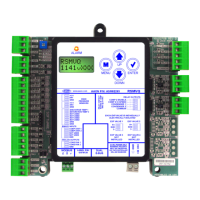14 RSMVQ Technical Guide
SEQUENCE OF OPERATIONS
Electronic Expansion Valve Operation and Head Pressure Control
Electronic Expansion Valve Operation
EXV operation is fully integrated into the Superheat Controller.
The Superheat Controller will measure suction pressure and
temperature to determine superheat and will automatically
modulate the EXV to maintain the congured superheat. The
RSMVQ will communicate with the Superheat Controller to set
the desired Superheat Setpoint and to retrieve operational data
for display and trending purposes.
Head Pressure Control
The RSMVQ can monitor a head pressure transducer and control
a condenser fan to maintain a Head Pressure Setpoint.
A condenser relay is commanded on when the rst compressor
is enabled. The condenser fan will be controlled with a 0-10
VDC output signal. When the condenser signal rst activates, it
maintains at 100% for 10 seconds.
In the Cooling Mode, the condenser signal will modulate to
maintain the Cooling Head Pressure Setpoint. The signal can
modulate between 15% and 100%. If the head pressure exceeds
550 psig, the condenser control signal will immediately go to
100% and a high head pressure alarm will be generated. The
alarm will be deactivated when the head pressure drops below
540 psig.
In the Dehumidication Mode, the Condenser Output Signal
controls to the Reheat Head Pressure Setpoint. High head
pressure conditions produce the same eects as in the Cooling
Mode.
If no head pressure sensor is detected, the Condenser Output
Signal will be maintained at 100%.
During condenser fan head pressure control, the Head Pressure
Setpoint will decrease when the VFD compressor speed
decreases. See Table 3, this page.
Compressor
Speed
Head Pressure Setpoint
(340 default - adjustable)
25% or lower 260 psig
25 - 100% 260 - 340 psig
100% 340 psig
Table 3: Compressor Speed/Head Pressure

